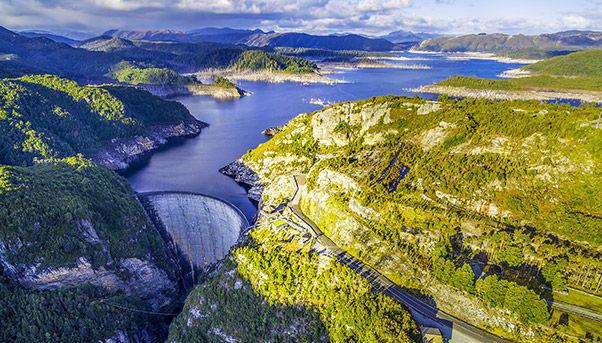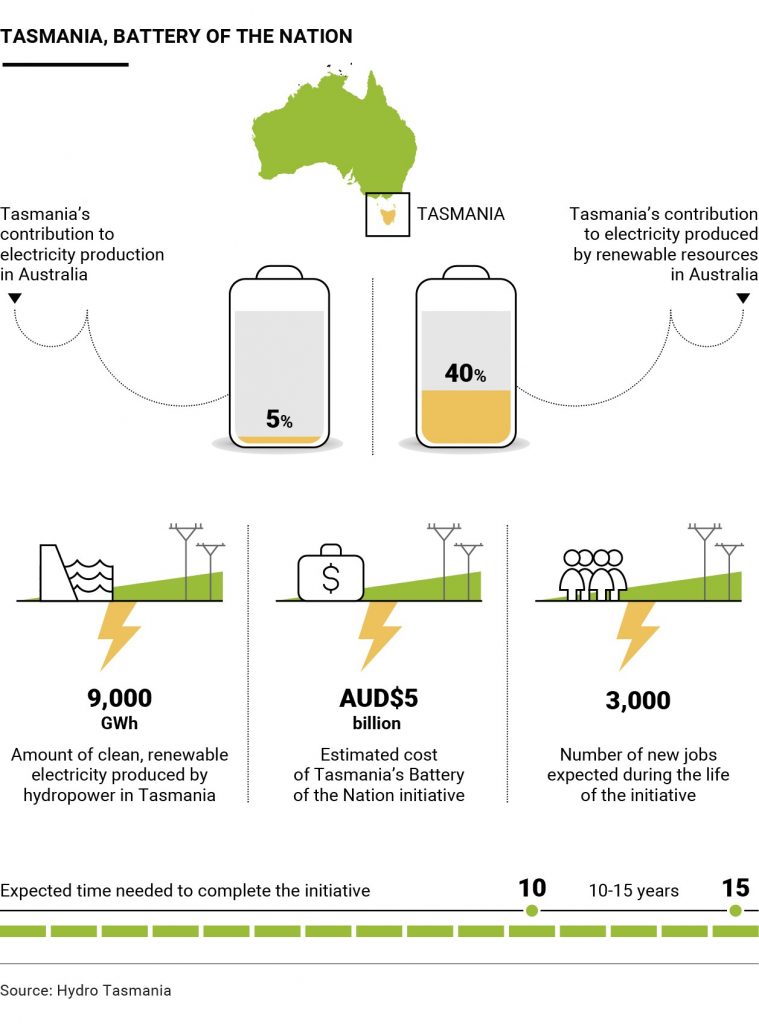
Tasmania, the smallest state in Australia with slightly more than 500,000 inhabitants, is ready to play its part in helping the country reduce its production of CO2 emissions – even if it means having to double its production of hydroelectricity.
As a signatory of the Paris Climate Agreement to fight global warming, Australia wants to reduce emissions by as much as 28% below its 2005 levels by 2030.
Since a lot of these emissions come from its use of coal to generate more than 70% of its electricity, the country is focusing its efforts on switching to renewable – and obviously cleaner – resources, especially sun and wind.
The switch has its risks, however. The production of electricity from these two sources can sometimes be volatile because the sun does not always shine and the wind does not always blow.
That is where Tasmania, an island off the southern coast of the Australian continent, plans to help.
As Australia’s largest generator of renewable energy, especially in hydro, it could ease the switch by making up for any unexpected drop in production on the mainland. Since hydro power can be tapped virtually on demand, it makes the island state ideally placed to do it.
Tasmania is one of the few places on Earth that produces nearly all of its electricity from renewable resources, especially hydro. It supplies more than 40% of Australia’s electricity produced from renewable resources. It is also home to the Roaring Forties winds, the utility also has a second renewable power source that it could easily tap.
«Tasmania is uniquely placed to help lead Australia through its challenging transition towards cleaner sources of energy», declares Hydro Tasmania’s chief executive, Steve Davy, on its website. Hydro Tasmania is the state-owned power utility responsible for most of the electricity produced on the island.
In addition to helping the mainland, the initiative would guarantee energy security for Tasmania for the next century and lower electricity prices for its residents and businesses.
Such is its confidence in taking up the challenge that Hydro Tasmania declares itself the future “Battery of the Nation” in light of the abundant supply of water power that it can harness.
As an indicator of the size of its ambition to help the mainland, Tasmania is responsible for a mere 5% of the total amount of electricity produced in Australia. But its contribution could increase dramatically in the coming years if it goes ahead with its plans.

Hydro Tasmania produces most of its electricity – about 9,000 gigawatt hours (GWh) a year – from hydro stations, enough for about 900,000 homes and small businesses.
The initiative that the utility is pursuing to help the mainland in its transition to renewable power sources would have it double the amount of electricity produced by hydro. Since it would produce more than it would need, the utility would export the surplus to the mainland via undersea cable. It only has one such cable at the moment, known as the Basslink, but others could be added in the future.
The initiative would cost up to AUD$5 billion and create up to 3,000 jobs during the 10-15 years needed to complete it.
In June, Hydro Tasmania published further details of its proposed initiative, saying it was exploring 14 pumped hydro storage schemes that together would have a production capacity of 4,800 megawatts (MW). It plans to choose the best among them in order to produce up to 2,500 MW, enough to light up 500,000 homes. «The first project could start construction as early as 2020, with a 3-4 year construction phase», it says.
Pumped hydro storage schemes would be a novelty for the island, and they would be built at existing hydropower facilities.
Their function is to store clean energy – water – on a large scale and release it on demand. A scheme has two reservoirs, one above a power station and another below it. It releases water from the upper reservoir to have it course through the station’s turbines and produce electricity. After the water empties into the lower reservoir, the scheme recycles it by pumping it back to the upper reservoir.
One such scheme, the Ingula Pumped Storage Scheme with a production capacity of up to 1,332 MW, was built by Salini Impregilo is South Africa.
One of the initiative’s options being considered would be to redevelop the Tarraleah scheme in the island state’s Central Highlands to more than double its capacity to 220 MW. Commissioned in the 1930s, it produces about 630 gigawatt hours of energy (GWh) per year, or 6.5% of Hydro Tasmania’s total output.
Another option would be to enhance Tasmania’s largest power station, known as Gordon, and increase its production capacity by 40%.
In addition to helping the mainland, the initiative would guarantee energy security for Tasmania for the next century and lower electricity prices for its residents and businesses.

